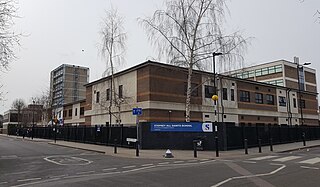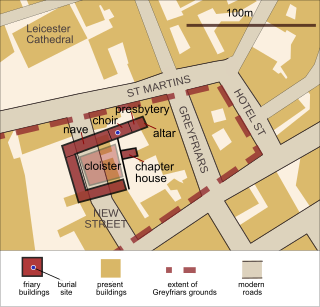
Dulwich College is a 2–18 private, day and boarding school for boys in Dulwich, London, England. As a public school, it began as the College of God's Gift, founded in 1619 by Elizabethan actor Edward Alleyn, with the original purpose of educating 12 poor scholars. It began to grow into a large school from 1857, and took its current form in 1870 when it moved into its current premises.

The Belfast Royal Academy is the oldest school in the city of Belfast, Northern Ireland. It is a co-educational, non-denominational voluntary grammar school in north Belfast. The Academy is one of 8 schools in Northern Ireland whose Head is a member of the Headmasters' and Headmistresses' Conference.
Sir John (Jack) Harold Plumb was a British historian, known for his books on British 18th-century history.

Campbell College located in Belfast, Northern Ireland and founded in 1894 comprises a preparatory school department and a senior Northern Ireland 'Voluntary Grammar' school, the latter meaning, in terms of provision of education, a government funded, selective school.

A blazer is a type of jacket resembling a suit jacket, but cut more casually. A blazer is generally distinguished from a sport coat as a more formal garment and tailored from solid colour fabrics. Blazers often have naval-style metal buttons to reflect their origin as jackets worn by boating club members.
Bishop Douglass Catholic School is a Roman Catholic co-educational secondary school and sixth form, situated in East Finchley area of the London Borough of Barnet, England. Its current Headmaster is Martin Tissot, a former pupil at the school.
Ballyclare High School is a co-educational, non-denominational grammar school in Ballyclare, County Antrim, Northern Ireland. There are approximately 1,200 pupils at the school, taught by around 80 teachers.

The City of Oxford High School for Boys was founded in 1881 by Thomas Hill Green to provide Oxford boys with an education which would enable them to prepare for University.
Leicester Grammar School is an independent secondary school situated in Great Glen, Leicestershire, England. It was founded in 1981, after the loss of the city's state-funded grammar schools.
Wellington School was a small private school in Wellington Road, Bebington, Metropolitan Borough of Wirral, England.
Matthew Humberstone Church of England School, also known as the Matthew Humberstone School, Matthew Humberstone C of E School, Matthew Humberstone Comprehensive School, MHS and Matty, was a secondary school in Cleethorpes, North East Lincolnshire, England, with a Church of England tradition. It existed between 1973 until it was closed due to amalgamation in 2010.
Bridgnorth Endowed School is a coeducational secondary school with academy status, located in the market town of Bridgnorth in the rural county of Shropshire, England. Founded in 1503, The Endowed School is a state school and is a specialist Technology College. The age range of the school is 11–18 years. It was previously known as the Bridgnorth Grammar School, and the school celebrated the 500th anniversary of its foundation in 2003. Former pupils include Professor Peter Bullock, the inspirational soil scientist who was a member of the Intergovernmental Panel on Climate Change (IPCC).
The school uniform is black and white, derived from the municipal colours of Edinburgh.
Queen Mary's School for Boys (QMSB) was a maintained grammar school in Basingstoke, Hampshire, England for boys aged 11–18. The school existed between 1556 and 1970 and was latterly funded by the Hampshire County Council Education Authority.

Stepney All Saints Church of England Secondary School is a Church of England voluntary aided school and sixth form located in Stepney, London, England. The last Ofsted report in October 2015 rated SJCR School as "Outstanding."

Greyfriars Kirkyard is the graveyard surrounding Greyfriars Kirk in Edinburgh, Scotland. It is located at the southern edge of the Old Town, adjacent to George Heriot's School. Burials have been taking place since the late 16th century, and a number of notable Edinburgh residents are interred at Greyfriars. The Kirkyard is operated by City of Edinburgh Council in liaison with a charitable trust, which is linked to but separate from the church. The Kirkyard and its monuments are protected as a category A listed building.

Greyfriars, Leicester, was a friary of the Order of Friars Minor, commonly known as the Franciscans, established on the west side of Leicester by 1250, and dissolved in 1535. Following dissolution the friary was demolished and the site levelled, subdivided, and developed over the following centuries. The locality has retained the name Greyfriars particularly in the streets named "Grey Friars", and the older "Friar Lane".
Hillside School was a private preparatory and pre-preparatory boys and girls school in Malvern, Worcestershire, England which was opened in 1870 and closed at the end of 1991 due to lack of demand in the area at the time. In the 1950s and 1960s it was a leading independent school in the area and had around 400 pupils.

King Richard III Visitor Centre is a museum in Leicester, England that showcases the life of King Richard III and the story of the discovery, exhumation, and reburial of his remains in 2012-2015.

Lincoln Grammar School or Lincoln Free School was formed as the result of the amalgamation of the Lincoln City Free School and the Lincoln Chapter Grammar School. The amalgamation occurred in January 1584, but the two schools may have been effectively working as single school from 1560. In 1574 Lincoln City Corporation had reached an agreement with Robert Monson who was donating the Greyfriars for use as a Grammar School. This was to replace an older City Free school, which had been in scholegate. The exact location of this Free school is uncertain, but scholegate probably refers to Danesgate, but other evidence suggests that the earlier school was close to St Rumbold's church.










